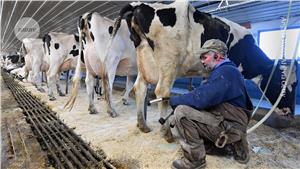Revolutionizing Lunar Exploration: The Role of Robots and Swarms in Establishing Moon Bases and Exploiting its Rich Mineral Resources - International Defense Security & Technology
The moon, Earth's celestial companion, has always fascinated humanity. In our quest to explore its mysteries and harness its resources, robotics and advanced technologies have emerged as the catalysts for revolutionizing lunar exploration. With the goal of establishing moon bases and tapping into its mineral wealth, we delve into the remarkable role that robots and robot swarms are poised to play in this transformative journey. Moon Opportunities and Challenges
Recent studies of the Moon's surface have shown that there is enough lunar ice underneath it to make extraction worthwhile. Moreover, lunar regolith contains metals and minerals in large amounts. The total value of the Moon's extractable resources amounts to USD sixteen quadrillion, as estimated by Moon Express. The water extracted from beneath the lunar surface can be processed into rocket fuel to feed expedition spacecraft flying to Mars and other planets in the Solar System. Interestingly, the price of this fuel will be 25 times lower than that delivered from the surface of the Earth (according to Jeff Bezos, the founder of Blue Origin). This difference in price is due to weak lunar gravity. Gravity force on the Moon is 6 times weaker than on Earth. This means that it will take much fewer rocket launches to deliver rocket fuel to outer space, which will determine the cost of fueling up in space. The economic and strategic benefits have ensued a global space race among countries to build Moon bases, harness it's mineral resources and helium-3, fuel for future nuclear fusion power plants. Space agencies in China, Japan, Europe, Russia, Iran , Canada and a few private companies all hope to send people to the moon by as early as 2025. They're talking about building bases, mining for natural resources, and studying the moon in unprecedented detail. A key figure at the European Space Agency says we must look at how we exploit the moon's resources before it is too late, as missions begin surface mapping. The Moon has no atmosphere; it is surrounded by a vacuum. It has an extremely weak magnetic field that does not protect it against solar and cosmic radiation. The Moon's surface is characterized by extreme drops in temperature. When the sunlight reaches the surface, it heats up to +130 °С; and when it is not illuminated by the Sun, the temperature drops to as low as –170 °С. These kinds of conditions create a lot of problems for building a long-term inhabited lunar base. The costs of creating a livable lunar base will be massive, and comparable with the size of the potential profits from the future sales of rocket fuel made from lunar ice. Colonization of the Moon using autonomous robots will be far more effective. Historically, the role of robotics in space exploration has been significant due to the uninhabitable conditions of non-terrestrial planets in the solar system. According to AZO Robotics, a robot is defined as "a self-controlled device consisting of electronic, electrical or mechanical units that can function in place of a living agent." The cost of lunar access and bringing the mined ores back to earth shall need to be reduced drastically through advances in propulsion, avionics, mining robots, launchers and spacecraft design. Key enabling capabilities for the exploration of the Moon are to be able to traverse over the surface between points of interest, gain access to sites of scientific importance, manipulate payloads and other hardware elements and to have the operational flexibility to perform these safely and efficiently. In this regard robotics and mobility are important elements operating on the surface either in support to autonomous missions or to human activities, as well as for mobile systems intended to transport humans over the surface. Mobile systems also represent only a subset of robotics which also includes dedicated manipulation systems such as deployment and manipulation arms. The Moon is close enough to the Earth (it is only three days away by spacecraft) meaning that it is possible to speak of regular cargo flights to the lunar surface. In addition, such a short distance allows monitoring robots there online and, if necessary, controlling the processes by radio from the Earth, allowing for minor delays in signal transmission. Each of the applications mentioned, from small-scale rovers and robotics, up to human and cargo transportation systems implies specific technologies and concepts from locomotion systems, surface navigation systems, intelligent manipulation robotics, varying degrees of autonomy etc. Such systems are by nature complex in the interaction of many components and elements, as well as their direct interaction with the planetary environment, and in particular the surface terrain. 50 years ago, the first lunar rover was already exploring the Moon's surface. Since that time, humanity has made significant progress in developing new electronic technologies and systems with AI components. A team of robots will be able to autonomously perform geological exploration, analyze samples, and ultimately start extracting minerals on the surface without any human intervention within 7-10 years. It is possible that the delivery of several robots weighing 150-200 kg each to the surface of the Moon could be carried out by several companies in the coming years. The competition between them will create reasonable prices for this kind of service. As of now, the following companies have announced that they are planning to start delivering cargo shipments to the Moon's surface: Blue Origin (Blue Moon project), Space X (Starship project), Roscosmos (Angara project), Yuzhnoye. Once their robots land on the Moon, it will be the start of a race to find the places on the lunar surface that would be best suited for mineral extraction. The subpolar regions will be explored first. The highest concentration of water molecules has been found at the bottom of subpolar craters untouched by sunlight. In addition, these regions have "eternal light" areas, where the Sun illuminates the surface at virtually all times. The energy of sunlight converted into electric current is a powerful source of free energy for future rocket fuel liquefaction and smelting plants. Exploring the Cosmos: Robots, Swarms, and the Future of Space Exploration The Robotic Vanguard:
From the iconic Apollo missions to the groundbreaking Chang'e program, robots have been our pioneers in lunar exploration. These mechanical marvels have withstood the harsh lunar environment, unveiling its geological secrets and paving the way for future endeavors. In the Apollo era, Lunar Rovers proved their worth, allowing astronauts to venture farther and gather diverse samples. The Chang'e rovers, Yutu and Yutu-2, undertaken by China, conducted comprehensive analyses of the moon's surface, contributing significantly to our understanding of its composition. Lunar Reconnaissance Orbiter (LRO): The Lunar Reconnaissance Orbiter, launched by NASA in 2009, remains a beacon of success. Equipped with cutting-edge instruments, LRO mapped the moon's surface in unprecedented detail. Its data, including topographical maps and resource assessments, has guided the selection of potential landing sites for upcoming missions. Chang'e and Lunar Prospector: The Chang'e program, notably Chang'e 4, marked another milestone by landing on the far side of the moon. This achievement opened up new vistas for exploration and has facilitated groundbreaking research on the moon's geology and cosmic environment. Additionally, the Lunar Prospector mission identified tantalizing hints of water ice at the poles, sparking interest in utilizing lunar resources. Startups developing Robots
Gitai
Gitai is a promising research startup in the field of space robots. The company has developed two main products that have the potential to revolutionize space exploration: a 2-meter inch-worm-like robotic arm and a Lunar robotic rover. The robotic arm is designed to perform tasks in space, such as maintenance and repairs on spacecraft and space stations. It is equipped with interchangeable tools, such as drills and shovels, and can be controlled remotely by astronauts. This arm could significantly reduce the need for astronauts to conduct spacewalks, which are dangerous and time-consuming. The Lunar robotic rover is designed to navigate and operate on the moon's surface. It is about the size of a go-kart and can be used to explore the moon, collect samples, and conduct experiments. This rover could be used to support future human missions to the moon, as well as to conduct autonomous exploration. Gitai is also developing other robotic technologies for space exploration, such as a robotic manipulator for assembling and maintaining satellites and a robotic arm for refueling spacecraft. The company is committed to advancing the possibilities of space exploration through robotics, and its technologies have the potential to make space travel safer, more efficient, and more affordable. Astrobotic Technology
Astrobotic Technology is a Pittsburgh-based company that is developing robots to deliver cargo to the moon and Mars. The company's flagship product is the Peregrine Lunar Lander, which is scheduled to launch in 2023. The Peregrine will be able to deliver up to 180 kilograms of cargo to the lunar surface. Astrobotic Technology Peregrine Lunar Lander Astrobotic is also developing a robot called the Griffin, which is designed to explore the moon's surface. The Griffin will be equipped with a variety of sensors and tools, and it will be able to collect samples, conduct experiments, and map the lunar surface. Honeybee Robotics
Honeybee Robotics is a New York-based company that is developing robots for a variety of space applications, including asteroid mining and planetary exploration. The company's most well-known product is the Sample Acquisition System (SAS), which is used to collect samples from asteroids and other celestial bodies. Honeybee Robotics Sample Acquisition System (SAS) Honeybee Robotics is also developing a robot called the Kilobot, which is a small, autonomous robot that can be used to swarm together to perform tasks. The Kilobot could be used to explore the lunar surface, assemble structures, or even mine for resources. Space Robotics
Space Robotics is a California-based company that is developing robots for space assembly and maintenance. The company's products include the SSRMS (Space Station Remote Manipulator System), which is used to maintain the International Space Station. Space Robotics SSRMS (Space Station Remote Manipulator System) Space Robotics is also developing a robot called the ARMROD, which is designed to repair and refuel satellites. The ARMROD could be used to extend the lifespan of satellites and keep them in orbit. Teledyne Brown Engineering
Teledyne Brown Engineering is a Maryland-based company that is developing robots for space exploration and defense applications. The company's products include the ARES (Autonomous Robotic Excavator System), which is designed to excavate on the moon and Mars. Teledyne Brown Engineering ARES (Autonomous Robotic Excavator System) Teledyne Brown Engineering is also developing a robot called the TARS (Tactical Autonomous Robotic System), which is designed to be used in military applications. The TARS could be used to disarm bombs, clear minefields, or perform other dangerous tasks. These are just a few of the many companies that are developing innovative robotic technologies for space exploration. The field is rapidly evolving, and these companies are playing a key role in making space travel a reality. Robot Swarms:
The emergence of robot swarms as a cutting-edge technology promises to reshape lunar exploration. These collectives of intelligent robots demonstrate remarkable capabilities that far surpass those of individual machines. Consider the Google Lunar XPRIZE, which spurred innovative approaches to lunar exploration. While the competition concluded without a winner, it fostered the development of technologies that can potentially reduce costs and increase efficiency through swarm-based systems. Astrobotic's Innovations: Private companies, too, are advancing lunar exploration. Astrobotic's Peregrine lander, set to launch in the near future, will carry a variety of payloads to the moon. Additionally, Astrobotic's CubeRovers present a novel concept—compact rovers that can be deployed en masse, covering extensive areas and gathering diverse data simultaneously. VIPER: Unlocking Lunar Resources: NASA's VIPER mission exemplifies the future of lunar resource utilization. This robotic rover, set to launch in the mid-2020s, will explore the moon's south pole, investigating the presence of water ice. By analyzing the distribution and concentration of these resources, VIPER lays the groundwork for sustainable lunar operations. NASA funded a project to mine the Moon with swarms of autonomous robots
In September 2021, NASA initiated a project aimed at mining the Moon using swarms of autonomous robots. Led by researchers at the University of Arizona, this project involves the development of a neuromorphic learning architecture called the Human and Explainable Autonomous Robotic System (HEART). Neuromorphic computing, inspired by brain functionality, is more energy-efficient compared to conventional computer chips. HEART's objective is to train robots to collaborate on mining, excavation, and construction tasks autonomously while enhancing their teamwork skills progressively. The lead of the project, Jekan Thanga, an associate professor of aerospace and mechanical engineering, is adapting the neuromorphic architecture to miniature sensors for use in autonomous robots. The team has designed 3D-printed rover prototypes for testing purposes, with the intention of refining their design to aid astronauts in lunar mining operations. The goal is for robots to perform laborious and hazardous tasks, allowing astronauts to focus on more complex activities. The researchers plan to train the robots on Earth before deploying them to the Moon. The long-term vision involves a fully autonomous swarm of robots capable of independently mining materials and constructing structures without needing constant instructions from Earth. The project tackles both autonomy and material excavation. While Thanga focuses on the autonomy aspect, Moe Momayez, another member of the team, has developed an electrochemical drilling process that is five times faster than traditional methods, addressing the challenge of efficient lunar mining in a resource-scarce environment. Here are some additional details about the project: - The HEART system uses a neuromorphic approach to learning, which is inspired by the way the human brain works. This approach is more efficient than traditional methods of machine learning, which can require a lot of energy and computing power.
- The robots in the swarm will be able to communicate with each other and share information, so that they can work together more effectively. This will allow them to complete tasks more quickly and efficiently than individual robots.
- The robots will be able to learn and adapt over time, so that they can improve their mining and excavation skills. This will make them more reliable and efficient in the long run.
Although lunar mining presents challenges due to the moon's limited resources and energy constraints, the project aims to pioneer innovative solutions for breaking rocks and extracting materials, ultimately advancing humanity's ability to exploit lunar resources. The Path Ahead:
The lunar race has already begun: currently, the competing parties are rocket-building companies, but in several years, we will see a sharp increase in the number of lunar robot developers. The robots and AI systems developed by them, as well as the reliability of such systems, will determine just how successful lunar mineral extraction companies will be. Projects are already being developed with the goal to claim as much territory as possible; the lunar Grasshopper by Moon Express is just one example. While the achievements are remarkable, challenges persist. Developing autonomous systems capable of navigating the moon's diverse terrain, ensuring reliable communication over vast distances, and addressing ethical considerations remain integral to the success of lunar exploration missions. As we stand at the threshold of an era defined by human-robot collaboration, the vision of establishing moon bases and tapping into its mineral resources is no longer confined to science fiction. Robots and swarms are our allies in this pursuit, bridging the gap between Earth and the moon, pushing boundaries, and turning dreams of lunar habitation into tangible reality. With every rover's wheel that rolls across the lunar surface, with each data packet transmitted back to Earth, we inch closer to a future where humans and robots coexist on the moon. The moon, once a distant orb in the sky, is now an attainable destination, thanks to the technological prowess and unwavering determination of humankind. References and Resources also include:
https://smprobotics.com/moon_robot/ https://room.eu.com/news/nasa-funds-project-to-mine-the-moon-with-swarms-of-autonomous-robots 2023-12-25 Rajesh Uppal









